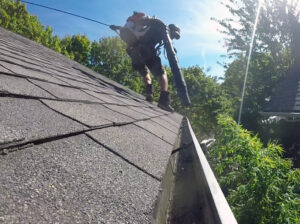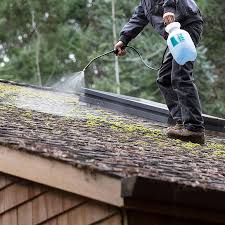Moss growth on roofs is a common problem that can lead to serious damage if left unchecked. Homeowners often underestimate the impact of moss, assuming it is just an aesthetic issue. However, moss retains moisture, which can lead to shingle deterioration, leaks, and structural damage. Proper removal and prevention techniques are essential for maintaining the longevity of a roof. In this guide, we will explore expert-backed strategies for effective moss removal, ensuring that your roof remains clean and durable.
Understanding Moss Growth on Roofs
 Moss thrives in damp, shaded environments, making roofs in humid or wooded areas particularly susceptible. It often starts as small green patches but can quickly spread, covering large portions of the roof. Factors that contribute to moss growth include inadequate sunlight, excessive moisture, and organic debris accumulation. If moss is not addressed promptly, it can lift shingles, trap water, and accelerate roof decay.
Moss thrives in damp, shaded environments, making roofs in humid or wooded areas particularly susceptible. It often starts as small green patches but can quickly spread, covering large portions of the roof. Factors that contribute to moss growth include inadequate sunlight, excessive moisture, and organic debris accumulation. If moss is not addressed promptly, it can lift shingles, trap water, and accelerate roof decay.
Homeowners may notice moss forming in areas where leaves and debris accumulate, preventing proper drainage. Once moss takes hold, it can be difficult to remove without professional guidance. Recognizing early warning signs and taking action immediately can prevent costly repairs in the future.
Safe and Effective Moss Removal Techniques
Moss removal requires careful execution to prevent roof damage. Many homeowners make the mistake of using aggressive methods that can shorten the lifespan of their roofing materials. The following techniques are widely recommended by professionals for safe and efficient moss removal.
One of the most effective approaches is a gentle hand-removal process. Using a soft-bristled brush or a plastic scraper, moss can be carefully lifted away without damaging shingles. It is important to work from the top of the roof downward to prevent lifting shingles or forcing water underneath. Excessive force should be avoided, as it can cause granule loss on asphalt shingles, reducing their protective capabilities.
Another common method involves applying a moss-killing solution. Professional-grade cleaning agents or homemade solutions, such as a mixture of water and mild detergent, can be sprayed onto the affected area. These solutions help loosen moss, making it easier to remove. However, harsh chemicals like bleach should be avoided, as they can damage roofing materials and harm surrounding vegetation.
Professional vs. DIY Moss Removal
While some homeowners prefer a do-it-yourself approach, professional moss removal services offer several advantages. Experienced professionals have the necessary equipment and expertise to remove moss effectively without causing roof damage. They also use specialized treatments that prevent regrowth, reducing the likelihood of recurring issues.
Attempting moss removal without the right tools or knowledge can be risky. Walking on a moss-covered roof is hazardous, as the surface can become slippery. Additionally, using improper cleaning methods may result in accidental damage, leading to costly repairs. Professional services ensure that the job is done correctly while minimizing safety risks.
For those who choose to handle moss removal on their own, it is essential to take proper safety precautions. Using a sturdy ladder, wearing non-slip shoes, and having a second person for support can prevent accidents. It is also advisable to choose a dry, cool day for the task to avoid unnecessary exposure to extreme weather conditions.
Preventing Future Moss Growth
Once moss is removed, taking preventive measures is crucial to keep it from returning. One of the most effective strategies is improving roof drainage. Keeping gutters clean and ensuring proper water flow prevents moisture buildup, making it harder for moss to grow.
Trimming overhanging tree branches allows more sunlight to reach the roof, reducing dampness and limiting moss-friendly conditions. Regular roof inspections help identify potential problem areas before moss has a chance to spread.
Some homeowners opt for zinc or copper strips installed along the roof ridge. When it rains, these metals release natural compounds that inhibit moss growth. This long-term solution is particularly effective in areas prone to frequent moss issues.
The Role of Regular Maintenance
Routine maintenance is key to preserving the condition of a roof. Checking for moss growth at least twice a year, particularly after the rainy season, allows homeowners to address minor issues before they become major problems. A well-maintained roof lasts longer, reduces the risk of leaks, and enhances the overall appearance of a home.
Cleaning roof surfaces periodically with a low-pressure wash can remove dirt, debris, and any early-stage moss growth. However, excessive pressure washing should be avoided, as it can erode shingle granules and cause premature wear.
Hiring a professional for an annual inspection ensures that the roof remains in optimal condition. Experts can detect early signs of moss growth, water damage, or structural issues that might not be immediately visible to homeowners. Preventative care ultimately saves time and money by avoiding costly repairs in the long run.
Choosing the Right Roof Cleaning Products
 Not all cleaning products are suitable for roof maintenance. Selecting the right moss removal and prevention solutions ensures effectiveness without harming roofing materials. Products with biodegradable ingredients are recommended, as they are safer for the environment and nearby plant life.
Not all cleaning products are suitable for roof maintenance. Selecting the right moss removal and prevention solutions ensures effectiveness without harming roofing materials. Products with biodegradable ingredients are recommended, as they are safer for the environment and nearby plant life.
Oxygen bleach is a popular choice, as it effectively kills moss without the harsh side effects of chlorine bleach. Commercially available moss-killing treatments often include instructions for proper application, ensuring that homeowners can use them safely. Consulting with a roofing professional before applying any product helps avoid unintended damage.
When to Seek Professional Help
While many homeowners can manage minor moss issues, there are instances when professional intervention is necessary. If moss has extensively covered the roof or caused visible damage, expert assistance is recommended. Signs that indicate the need for professional help include persistent moisture issues, sagging roof sections, and loose or missing shingles.
Roofing specialists not only remove moss but also assess the underlying condition of the roof. If structural problems are detected, they can recommend appropriate repairs to prevent further deterioration. Addressing moss growth as part of a broader roof maintenance strategy ensures the home remains well-protected.